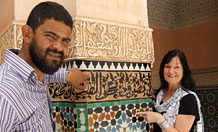-
- Information for new students
- About us
- News
- Events
- Prospective undergraduates
- Prospective postgraduates
- Employability
- Research
- Staff profiles
- Arab and Islamic Studies
- Education
- Law
- Politics
- Sociology, Philosophy and Anthropology
- Strategy and Security Institute
- Exeter Q-Step Centre
- Outreach
- Alumni
- Contact us
- Health and Safety
- Current students
- Staff intranet

Mohammed Abaoubida and Dr Elaine M Goodwin with the 14th-century Merenidian Medersa Ben Yousef, situated in the heart of the medina in Marrakech.
Ancient art forms shine light on religion
Two artists from England and Morocco apply the ancient beauty of mosaic and calligraphy in a new exhibition that explores life and religion.
The ‘From Here to Eternity’ exhibition opens at the University of Exeter’s Institute of Arab and Islamic Studies, on Thursday 27 January. It is the result of long and profound discussions on the theme over many years, in Marrakech where both artists have studios, and in Elaine’s studio in Exeter. Over the last two years they have been concentrating on producing work for the exhibition working independently on 20 works each and coming together to produce one joint work.
Dr Goodwin said, ‘Through the materials of ancient Byzantium, such as marble,Venetian gold leaf and glass I am able to express my views on life, death and love. I am able to relay something of how I understand them through a personal interior exploration, not through a conventional belief system.’
The ancient forms of art are used in a 21st-century way, mirroring how religions can develop independently yet retain channels of open dialogue. Abaoubida said ‘This is a unique opportunity for us to show the world how two different viewpoints and cultures can join in harmony.’
The renowned calligrapher felt that it was his destiny to draw and write, he added “When I was 10 years old my teacher asked me to write a phrase on the blackboard. I wrote it in beautiful handwriting. He looked intently at me and said “God has given you a gift”. I lay out the colours of my paintings as I like and draw their characters and meanings.”
In Morocco there is a strong tradition of combining mosaic with calligraphy. One example is the 14th-century Merenidian Medersa Ben Yousef, situated in the heart of the medina in Marrakech near the artists’ studios. Here, embossed suras from the Koran in Kufic and cursive script co-exist with small cut mosaic tiles, the Zellijs. This duality of mosaic with calligraphy is born from an Arab-Andalusian tradition and can be experienced in the 10th-century mihrab of the Great Mosque of Cordova in Spain, where shimmering gold and glass combine calligraphy.
The opening of the exhibition coincides with the inauguration of the Institute’s Centre for the Study of Islam, with a lecture by Professor Hoyland, University of Oxford, about ‘The Language of the Qur’an and Ancient Middle Eastern Storytelling’, at 5.15pm. The Centre for the Study of Islam brings together the diverse Islamic Studies activity within the University’s Institute of Arab and Islamic Studies, with expertise ranging from early Islamic thought to modern Muslim belief and practice, from Islamic philosophy to the pressing issues facing the UK Muslim community.
Professor Robert Gleave, whose specialism’s include Islamic law, Muslim hermeneutics and Shi’ism, is the first director of the new Centre. He said, ‘The Centre’s research will fall under four headings, History and Development of Islamic Thought, Islam and Muslim Communities in Minority Contexts, Radical Islamism and Deradicalisation and Shi’i Studies. We currently supervise more than 25 PhD students on aspects of Islamic Studies. Alongside the dedicated MA in Islamic Studies, it creates a vibrant research environment in which the study of Islam will continue to develop at the University of Exeter.’
Date: 25 January 2011
